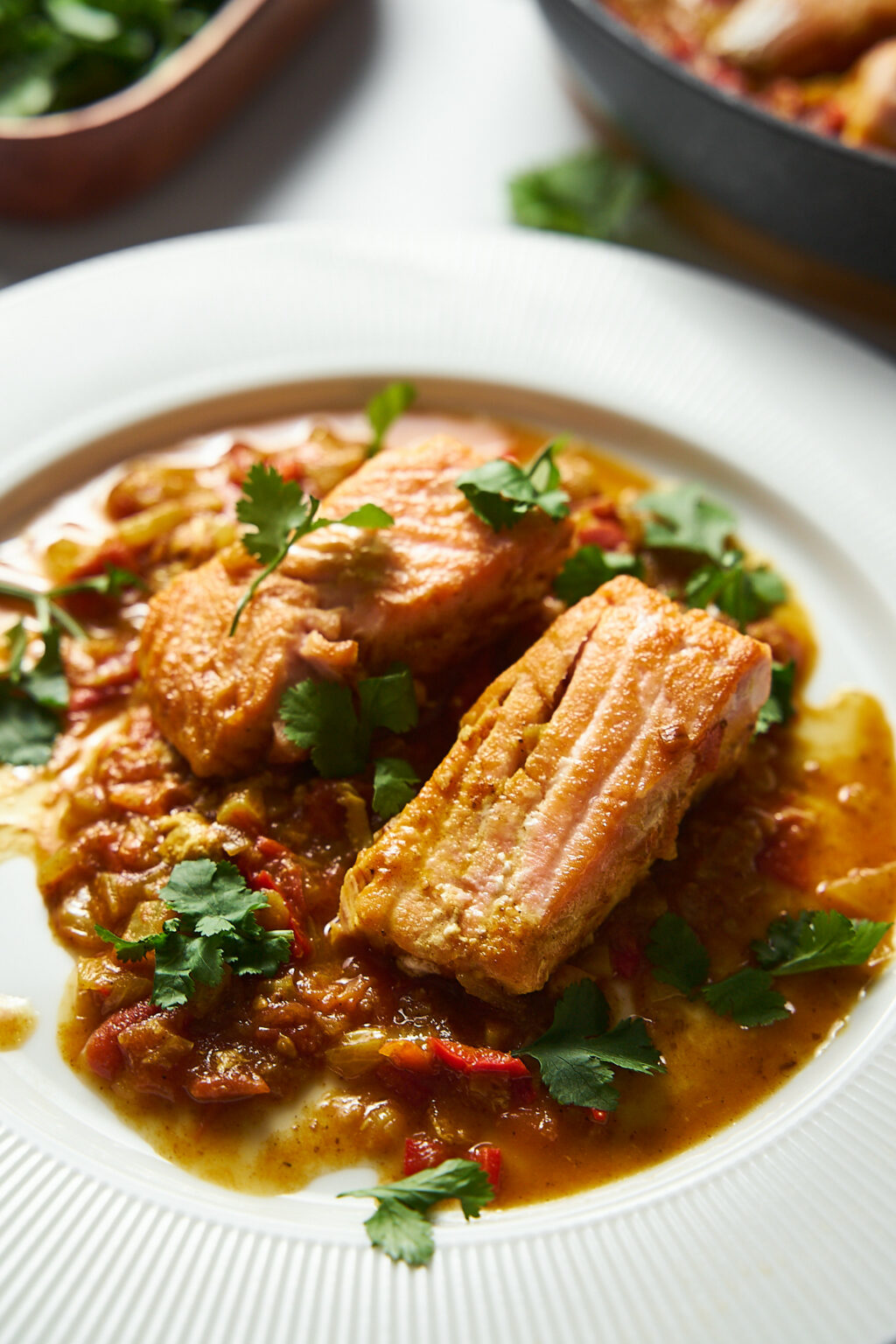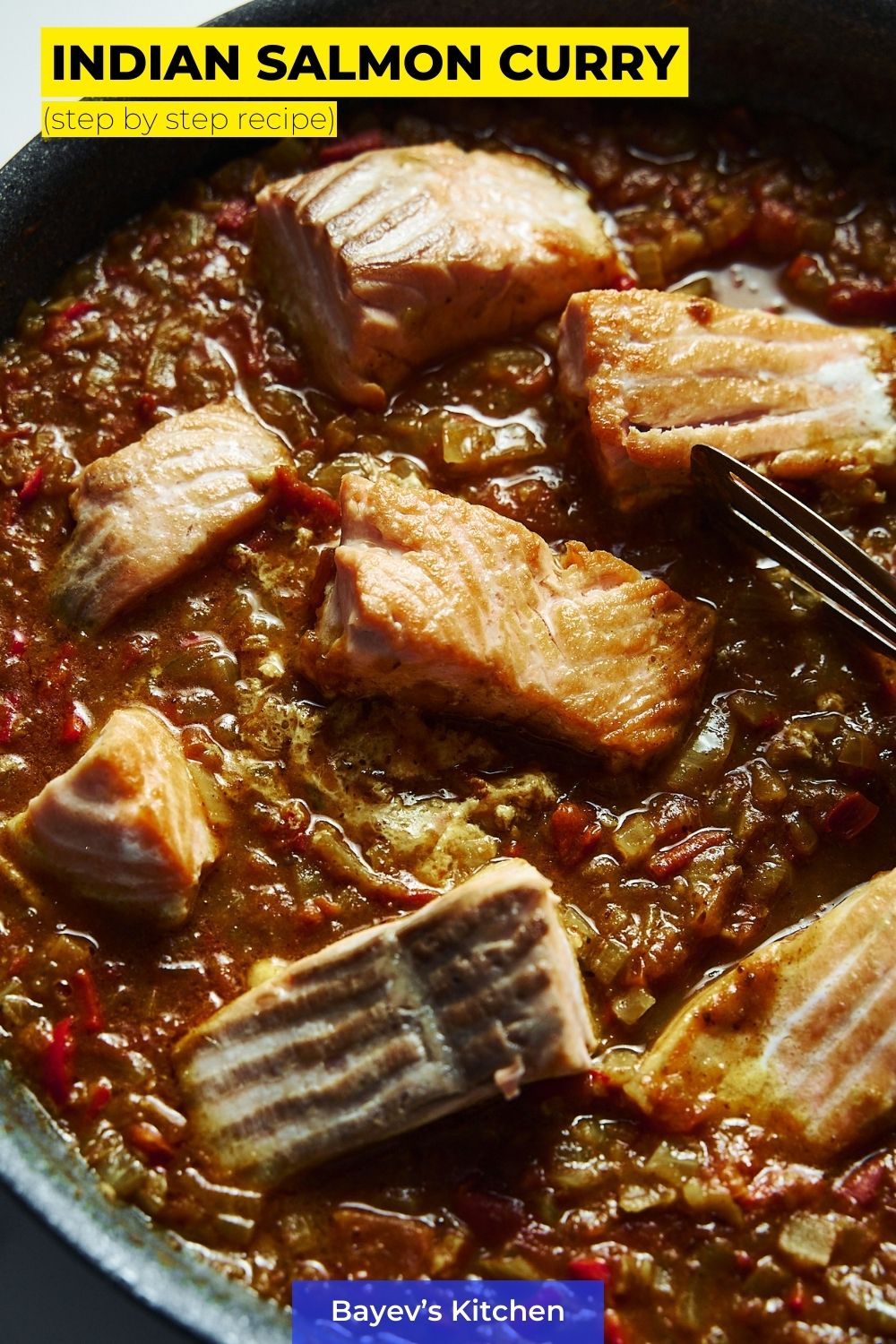The Indian salmon curry has a long history, dating back to the Great Mughal Empire, and is one of the staple dishes of Indian cuisine.
The origin story of Indian curry is not entirely clear, but it is believed that this dish originated in South India. Legend has it that the emperor of the Great Mughals, Akbar, once demanded a dish to be prepared that would be both nutritious and tasty for his soldiers. In response, the court chef prepared a curry made from a mix of spices and fish. Since then, this dish has become popular and has spread throughout India and beyond.
In the version of Indian salmon curry that I propose, a mixture of cumin, coriander, garam masala, and turmeric – traditional Indian spices, are used, giving the dish a warm and earthy aroma, while garlic, onions, ginger, and red chili add a spicy edge, and tomatoes and lime balance freshness and acidity.
Salmon — the main character of the dish, goes perfectly with the rich and spicy curry taste. The degree of spiciness of the dish can be adjusted to taste, varying the amount of chili pepper used.
Overall, Indian salmon curry is a tasty and filling dish that offers a balance of bold flavors and textures. It perfectly reflects the rich and diverse cuisine of India and is fairly easy to prepare, making it an excellent option for a flavorful weekday dinner.

How to cook Indian salmon curry with coconut milk?
Often, salmon curry is made with the addition of coconut milk, giving it a creamier texture and a delicate taste.
In the recipe I suggest, we will prepare curry without it to achieve a more intense and vibrant taste of Indian spices that go so well with salmon.
But if you want to prepare a more classic version — you can replace the water in the recipe with it or add at the end of cooking, when the curry is already ready. The latter option will provide a creamier texture and a richer coconut taste.
Contents
⏱ Cooking time — 45 minutes overall. Includes 25 minutes of preparation and cooking + 20 minutes unattended.
🔪 Ingredients
For 4 servings:
- 500 g (17.6 oz) salmon fillet
- 2 cloves garlic
- 1 large onion
- 1 tsp. (0.1 oz) cumin seeds
- 1 tsp. (0.1 oz) coriander seeds
- 1 tsp. (0.1 oz) garam masala
- 1-2 red chilies
- 1 tbsp. (0.3 oz) grated ginger
- ½ tsp. (0.1 oz) turmeric
- 250 g (8.8 oz) tomatoes
- 250 ml (1 cup) water
- cilantro for garnish
- ½ lime juice and zest
- salt

🥣 Directions
Preparing the Spices
Start by toasting the spices in a dry pan. To do this, put 1 tsp. of cumin and 1 tsp. of coriander seeds into a hot, dry pan.
Toast on medium heat, stirring constantly, until you can smell a strong aroma, about 1-2 minutes.
Then add 1 tsp. of garam masala and toast for another 10-15 seconds. Remove the spices from the pan and grind them into a powder using a mortar and pestle.
Preparing the Salmon
Remove the skin from 500 g (17.6 oz) of salmon fillet and remove any bones with tweezers. Cut the fillet into 4-6 pieces of roughly equal size. Season on both sides and set aside.
Preparing the Vegetables and Spices
Peel and chop 1 large onion into medium cubes. Peel 2 cloves of garlic and 10 g of ginger. Grate them on a fine grater and set aside.
Preparing the Vegetables for the Sauce
Cut off the ends of 1-2 red chilies, tap them with a knife, then shake out the seeds. Finely chop.
Remove the stems from 250 g (8.8 oz) of tomatoes, cut them in half, and chop them into small pieces. Transfer to a deep plate and set aside.
Cut the stems off of cilantro sprigs, and finely chop the top part for garnish.
Frying the Salmon and Preparing the Sauce
Heat a pan over medium heat, add a little oil, and fry the pieces of salmon on both sides for 1-2 minutes, then transfer to a plate.
In the same pan, sauté the onion until soft, about 5-6 minutes, stirring frequently. Add the finely chopped chili and sauté for 2-3 minutes, stirring.
Add the toasted spices, garlic, and ginger, cook while stirring constantly for about 40 seconds.
Adding Tomatoes and Water, Serving the Dish
Add the tomatoes, stir, bring to a boil and cover. Reduce the heat to low and simmer for 5-6 minutes, stirring occasionally.
Remove the lid and pour 250 ml (1 cup) of water into the pan, season with salt, stir, increase the heat and bring to a gentle boil.
Squeeze the juice of half a lime and taste for salt, stir. If needed, add a little more salt.
Using a spoon, make small wells in the sauce, then carefully place the pieces of salmon in them so that they absorb the flavors of the sauce.
Cover with a lid, reduce the heat and simmer for 2-3 minutes. The internal temperature of the salmon should be around 58-60°C (140°F) when it’s done.
If you prefer not to sear the salmon first, you can add it raw to the sauce and cook for about 6-7 minutes, or until it reaches the desired internal temperature mentioned above.
Remove the pan from the heat, and distribute the thick sauce onto plates. Place the salmon on top and garnish with chopped cilantro.

🙋♂️ FAQ
What is Salmon Curry Indian?
Salmon Curry Indian is a flavorful dish where salmon pieces are cooked in an aromatic blend of Indian spices, tomatoes. It’s a one-pot dish, perfect for any meal and pairs well with rice or Indian bread.
What kind of salmon is best for Indian Salmon Curry?
It’s best to use fresh, boneless salmon fillets for Salmon Curry Indian. Both farm-raised and wild salmon work well. The fish should be firm and have a fresh scent.
What spices are typically used in Indian Salmon Curry?
Traditional spices used in Salmon Curry Indian include turmeric, cumin, coriander, chili powder, and garam masala. Fresh ingredients like garlic, ginger, and green chilies are also commonly used.
Can I make the curry in advance?
Yes, you can make the curry sauce in advance and refrigerate it for up to 2 days. When you’re ready to serve the dish, heat the sauce, add the salmon pieces, and simmer until the fish is cooked.
Can I freeze Indian Salmon Curry?
Yes, you can freeze Salmon Curry Indian. However, fish can become a bit dry when frozen and reheated, so it’s best to freeze just the curry base, and add fresh fish when you’re ready to serve it.
What can I serve with Indian Salmon Curry?
Salmon Curry Indian pairs well with basmati rice, naan bread, or roti. It can also be served with a side of cooling yogurt, pickle, or a fresh cucumber salad.
How can I make Indian Salmon Curry spicier or less spicy?
The spice level can be adjusted according to your taste. You can increase the amount of chili powder or green chilies to make it spicier. To make it less spicy, reduce these ingredients or add more coconut milk or cream.
Can I use other types of fish for this curry?
Yes, you can replace salmon with other firm-fleshed fish like cod, halibut, or even shrimp. However, the cooking time may vary depending on the type and size of the fish or seafood used.
What is the best way to ensure the salmon doesn’t overcook in the curry?
Salmon cooks relatively quickly, especially when cut into smaller pieces. To avoid overcooking, add the salmon to the curry only in the final stage of cooking and simmer just until the fish is opaque throughout.
Can I use canned salmon in Salmon Curry?
While fresh salmon is preferred, canned salmon can be used as a last resort. Be sure to thoroughly drain and flake the salmon before adding it to the curry.
Can I add vegetables to my Indian Salmon Curry?
Absolutely, adding vegetables like bell peppers, peas, or spinach can enhance the nutritional value and flavor profile of the dish. Make sure to adjust the cooking time accordingly.
How can I store leftovers of Salmon Curry?
Leftover Salmon Curry Indian can be stored in an airtight container in the refrigerator for up to 2 days. Reheat gently over low heat.

Salmon Curry Indian

Ingredients
- 500 g salmon fillet
- 2 cloves garlic
- 1 large onion
- 1 tsp. cumin seeds
- 1 tsp. coriander seeds
- 1 tsp. garam masala
- 1-2 red chilies
- 1 tbsp. grated ginger
- ½ tsp. turmeric
- 250 g tomatoes
- 250 ml watercilantro for garnish
- ½ lime juice and zest
- salt
Instructions
- Roast the cumin, coriander seeds and garam masala. Grind them to a powder.
- Remove the skin and bones from the salmon fillets, cut into equal pieces, salt.
- Cut onion into medium cubes, grate garlic and ginger.
- Chop chilies, chop tomatoes, chop cilantro.
- Fry salmon slices, then onion and chili. Add roasted spices, garlic and ginger.
- Add tomatoes, pour in water, salt, and squeeze the juice of half a lime. Place salmon in sauce and stew for 2 to 3 minutes. Spread thick sauce on plates, place salmon on top and garnish with chopped cilantro.
